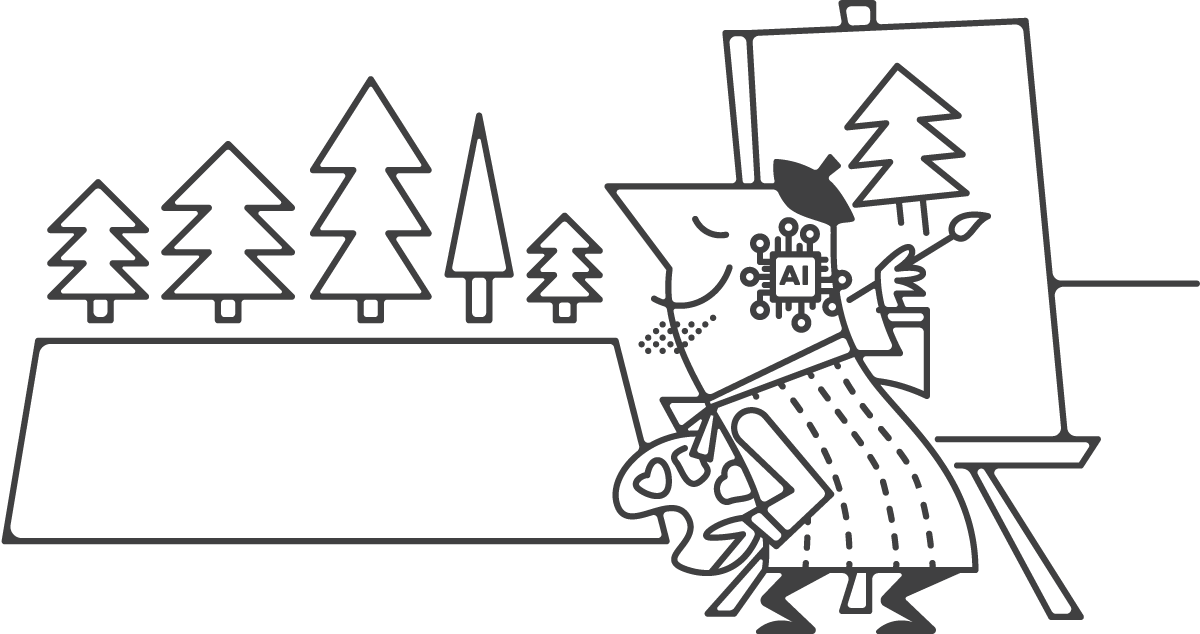“Average is as average does.”
Over the decades, new technologies have always helped mold and shape the landscape of the branding and marketing industries. With the dawn of desktop publishing, we swapped traditional hardware for software to primarily design brand logos, collateral and packaging. The birth of social media reconfigured how businesses connect with their customers and grow their brand. Now we find ourselves in a new renaissance with the rise of Artificial Intelligence (A.I.) producing new artwork, photographs, video, audio, messaging and other textual content. And while this can be a revolutionary tool to be used for the purpose of creating your visual branding, the results will give you another A.I. — Average (brand) Identity.
For many people, exactly how Artificial Intelligence can create such things with just a few words typed into an input field is a mystery. So, let’s break that down first.
A.I. art generators (as they are called) are inputted with large language models which reference millions of data points. In the case of image generators, these data points are created by researchers feeding millions and millions of images that are assigned data sets so the generator has text references to each image.
Textual prompts are then entered and give the generators “directions” and it then assembles a fusion of images that match those directions and produces a set of results to the prompter. These images can then be refined and filtered down even further like a funnel until the final imagery has been produced by the generator to the prompter’s satisfaction. Voila, you have your visual brand — be it a logo, a label design, or main advertising image. It’s no wonder this new tech tool has been so well received by small business owners trying to watch their costs and run their businesses and branding more independently. What could be wrong with that? Average is what is wrong with that.
We have all experienced predictive behavior in our email and text messaging apps. They give us suggestions for a word we appear to be misspelling or even giving us prompts to finish our sentences. Similarly, A.I. image generators create new images through averaging its data points’ corresponding references and using predictive models to create an average. For instance, if 1 out of 10 people believe the earth is flat, when prompted to create an image of Earth, the generator is going to predict what the average person believes the earth to be and would produce a round sphere for its rendition of the earth (unless it was specifically prompted to render the earth flat). It predicts through averaging what the prompter will want to see.

Let’s give a more practical example. If someone is using AI to generate a logo for their business with an icon of a tree in it, the generator will reference millions of tree images. Tall trees. Short trees. Fat trees. Slim trees. The small set of images it would produce will show very similar, average trees. Mostly of medium height and medium thickness. In the case of brand marks, the results of the tree icon will mostly look like your average pine tree as that is one of the more popular instances of tree icons out there. It is predicting what most people will associate with a tree and produce that. As Forrest Gump might have put it, “Average is as average does.”
For a visual brand to be successful, it needs to intuitively connect with the audience, but more importantly, it needs to stand out from the rest in a creative way. To not be average and ordinary, but extraordinary. A successful visual brand demands to be different and not conform to the norm. Out-of-the-box creativity requires connecting dots that are not intuitive and ones you wouldn’t normally connect. Seeing things from a new angle and not from what the majority has done previously. Intelligently and intentionally forming creative concepts that differ from what the majority in the market are doing.
So is A.I. generated imagery to be shunned like the Devil? The answer is “no”. In essence, it is a new tool for those in the industry to make use of. For concept exploration, reference material or for other developing purposes, A.I. can be a benefit and a time-saver. But, just because I can purchase dental tools, I am not qualified to give you a root canal. Similarly, just because you can purchase Adobe Illustrator doesn’t mean you — or one of your employees — are qualified to design your brand logo or collateral.
When it comes to using this new tool we call Artificial intelligence, a prompt is a concept and an average concept will produce average results, so be mindful of the danger of utilizing AI into your brand or brand messaging… but only if you want it to be have a great brand that stands apart from the rest.

